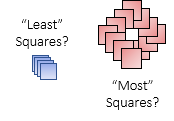Least Squares Lite
This topic covers general terminology, simple least squares (LS) adjustment applications, and basic adjustment statistics. It builds on the concepts of Chapter F. Random Errors in the II. Errors topic. Theory is discussed but derivations are included only insofar as needed to explain particular applications - and demonstrate why software is ususally employed. For more detailed explanations with supporting theory, derivations, and mathematics, please consult a textbook on survey data adjustments. An excellent text is Adjustment Computations and Spatial Data Analysis by C. Ghilani, John Wiley & Sons, Inc, publishers. I believe it is in its sixth edition. Another is Analysis and Adjustment of Survey Measurements by E. Mikhail and G. Gracie, Van Nostrand Reinhold, publishers. I think it is out of print but can be found at used book sites. Some surveying textbooks include a general chapter or appendix on least squares which can also be helpful.
There is a lot more to data adjustment and analysis than presented here. Statistical testing, adjustment validity, blunder detection, etc, are all important but beyond the scope of this website. The intent is to provide background so users understand a bit more about the effect and handling of random errors. Other Topics on this site described typical random error sources and behavior for individual measurements. Their cumulative effect on a closed network was eliminated using a simplified adjustment technique, which treated random errors systematically. Least squares provides the tools to better model and compensate random errors.
Least squares is a better, more correct, way to deal with errors, but it's no panacea. It can be applied incorrectly (quite easily, as a matter of fact) and requires appropriate decisions on the part of the user. Results can only be as good as network design and quality of the measurements.
Hopefully this topic will provide the user a basic framework and possibly whet the appetite to explore and experiment further.
